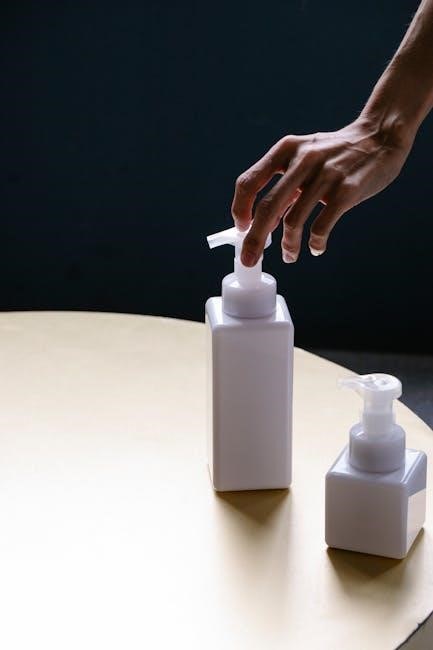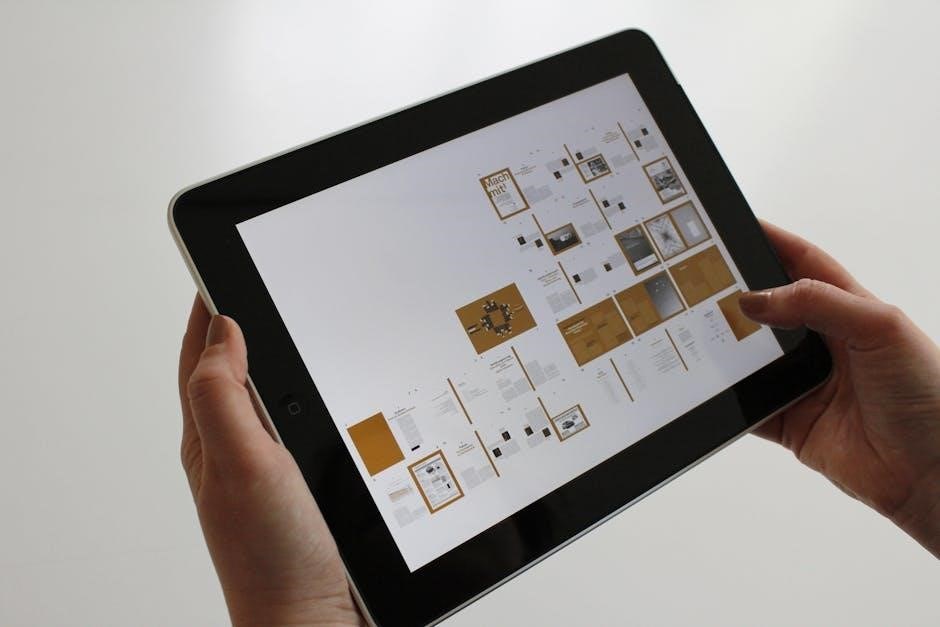cadd-solis pump user manual
Welcome to the CADD-Solis Pump User Manual. This guide provides essential information for safe and effective use of the CADD-Solis ambulatory infusion pump. Designed for healthcare professionals and patients, it covers setup, operation, and maintenance. Proper use ensures accurate medication delivery and patient safety; Read carefully before operating the device.
1.1 Overview of the CADD-Solis Pump
The CADD-Solis pump is a portable, ambulatory infusion device designed for accurate and reliable medication delivery. It supports continuous and bolus infusions, ensuring flexible treatment options. Key features include programmable settings, alarm systems, and user-friendly help screens. Its compact design promotes patient mobility, making it ideal for home and clinical use. Suitable for various therapies, this pump enhances patient care and safety, benefiting both healthcare professionals and patients alike.
1.2 Importance of Reading the Manual
Reading this manual is critical for safe and effective operation of the CADD-Solis pump. It provides detailed instructions, warnings, and troubleshooting guidance to ensure proper use. Failure to follow instructions may lead to improper operation, potentially compromising patient safety. Understanding the pump’s features, programming, and maintenance is essential for accurate medication delivery. Always refer to this manual for questions or concerns about setup, operation, or troubleshooting.
1.3 Target Audience
This manual is intended for healthcare professionals, including nurses and doctors, responsible for setting up and operating the CADD-Solis pump. Patients and caregivers who use the pump for home infusions will also benefit. It provides clear instructions for programming, monitoring, and maintaining the device. Understanding the content ensures safe and effective use, promoting patient care and safety. Proper training is essential for all users to maximize the pump’s functionality and minimize risks.

Features of the CADD-Solis Pump
The CADD-Solis Pump is portable, lightweight, and battery-operated, offering continuous or intermittent infusion modes. It features programmable settings, alarms, and help screens for easy troubleshooting and patient safety.
2.1 Design and Portability
The CADD-Solis Pump is lightweight and compact, designed for patient mobility. Its ergonomic design allows easy wearing, with a durable construction for long-term use. Battery-operated, it supports continuous therapy without compromising portability. The pump’s small size ensures discreet operation, enhancing patient comfort and independence during treatment. Its user-friendly interface and robust build make it ideal for both clinical and home care settings, promoting seamless therapy management.
2.2 Types of Infusion Supported
The CADD-Solis Pump supports multiple infusion types, including continuous, intermittent bolus, and patient-controlled analgesia (PCA). It allows precise delivery of medications, fluids, or chemotherapy. The pump accommodates various administration routes, such as intravenous, subcutaneous, and epidural. Its flexibility meets diverse clinical needs, ensuring accurate and customizable therapy. This versatility enhances patient care and accommodates different treatment protocols, making it suitable for a wide range of medical applications.
2.3 Alarm Systems and Notifications
The CADD-Solis Pump features a comprehensive alarm system to ensure safe operation. Visual and audible alerts notify users of low battery, occlusion, or other system issues. Specific alarms indicate when a dose is ready or if an error occurs. These notifications are critical for maintaining proper function and patient safety. The pump also includes help screens to guide troubleshooting, ensuring timely resolution of any issues that arise during use.

Setting Up the CADD-Solis Pump
Setting up the CADD-Solis Pump involves unpacking, inspecting, and preparing the device for safe initial use. Follow these steps to ensure proper function and safety.
3.1 Unpacking and Inspection
When unpacking the CADD-Solis Pump, carefully inspect all components for damage. Ensure the pump, tubing, cassette, and accessories are included. Check for cracks or wear. Verify the integrity of the medication cassette reservoir and administration tubing. Handle all components with care to avoid damage. If any items are missing or damaged, contact your supplier or healthcare provider immediately before proceeding. Proper inspection ensures safe and effective use of the device.
3.2 Loading the Medication Cassette
To load the medication cassette, first remove the blue plastic clip. Insert the cassette into the pump, ensuring it aligns with the guide rails. Gently push until it clicks securely into place. Verify the cassette is properly seated and the pump recognizes it. Follow the on-screen prompts to confirm loading. Always use sterile technique when handling the cassette and medication. Proper loading ensures accurate medication delivery and prevents errors;
3.3 Priming the Tubing
To prime the tubing, remove the blue plastic clip and attach the administration tubing to the cassette. Close the pinch clamp and ensure the tubing is securely connected. Follow the on-screen instructions to begin priming. The pump will automatically fill the tubing with medication. Verify that no air bubbles are present and that the tubing is properly primed. This step ensures accurate medication delivery and prevents air from entering the system. Always use sterile technique to avoid contamination. Proper priming is essential for safe and effective infusion.

Operating the CADD-Solis Pump
Understand the pump’s operation, including turning it on/off, navigating the interface, and starting/stopping infusion. Use proper techniques to ensure safe and effective medication delivery.
4.1 Turning the Pump On and Off
To turn the CADD-Solis Pump on, press and hold the power button until the display lights up. Ensure the battery is charged for proper operation. To turn it off, press and hold the same button until the display turns off. Always confirm the pump is off before storing or handling. Refer to the manual for specific steps and safety precautions to avoid unexpected interruptions or alarms during operation. Proper power management ensures patient safety and accurate medication delivery. Always verify the pump’s status before proceeding with any infusion-related tasks. Use the provided instructions to familiarize yourself with the power cycle process. This ensures smooth functionality and minimizes risks associated with improper shutdown. Always follow the manufacturer’s guidelines for turning the pump on and off to maintain its performance and longevity;
4.2 Navigating the Interface
Navigate the CADD-Solis Pump interface using the arrow keys to scroll through menus. Select options by pressing the confirm button. The home screen displays current infusion status, while menus provide access to settings and logs. Use the help screens for troubleshooting guidance. Ensure the keypad is unlocked before making adjustments. Familiarize yourself with the interface layout to efficiently manage infusion parameters and access critical functions. Proper navigation ensures accurate settings and safe operation. Always refer to the manual for detailed guidance on interface features and shortcuts.
4.3 Starting and Stopping Infusion
To start infusion, unlock the keypad, navigate to the infusion options, and confirm your selection. The pump will begin delivering medication according to the programmed settings. To stop, repeat the process and confirm cessation. Always monitor the pump’s status screen for confirmation. If alarms sound, address them promptly. Ensure all steps are followed carefully to maintain safe and accurate infusion delivery. Refer to the manual for detailed instructions on starting and stopping procedures.

Programming the CADD-Solis Pump
This section guides you through programming the CADD-Solis Pump, including setting infusion rates, configuring bolus doses, and using help screens for troubleshooting. Proper programming ensures precise medication delivery and patient safety. Follow the steps carefully to configure the pump according to your specific needs, and remember to lock the keypad to prevent accidental changes.
5.1 Setting Infusion Rates
To set the infusion rate on the CADD-Solis Pump, navigate to the programming menu and select the rate option. Enter the desired rate using the keypad, ensuring the unit of measurement (e.g., mL/hour) is correct. Confirm the setting to activate. The pump will display the rate for verification. For PCA mode, additional parameters may apply. Always review settings before starting infusion to ensure accuracy and patient safety. Use help screens if needed for guidance.
5.2 Configuring Bolus Doses
To configure bolus doses on the CADD-Solis Pump, access the bolus setup menu. Enter the desired dose amount and delivery interval using the keypad. Select the unit of measurement (e.g., mL or mcg) and confirm the settings. The pump will display a confirmation message. For PCA mode, set the lockout interval to prevent excessive dosing. Always review the bolus parameters before saving. Use the help screen for additional guidance if needed.
5.3 Locking and Unlocking the Keypad
To lock the keypad, press and hold the Unlock button until “Key Locked” appears. This prevents accidental changes. To unlock, press the same button until “Key Unlocked” displays. In PCA mode, locking requires an administrator code. Use the navigation arrows to enter the code and confirm. Always lock the keypad after programming to ensure patient safety and prevent unauthorized adjustments. Refer to the manual for additional security features and codes.
Maintenance and Troubleshooting
Regularly clean and disinfect the pump. Replace the battery when low. Resolve alarms promptly by checking tubing and cassette. Consult the manual or contact support for unresolved issues.
6.1 Cleaning and Disinfecting
Regular cleaning and disinfecting of the CADD-Solis Pump are essential to prevent germ growth and ensure proper function. Use a mild detergent and water to wipe the exterior. Avoid harsh chemicals or abrasive materials. Disinfect with a 70% isopropyl alcohol solution, ensuring all surfaces are covered. Allow the pump to air-dry completely before reuse. Regular maintenance helps maintain accuracy and patient safety. Follow the manual for detailed cleaning procedures.
6.2 Replacing the Battery
To replace the battery, turn off the CADD-Solis Pump and locate the battery compartment. Remove the old battery and insert a new one, ensuring correct polarity. Close the compartment securely. Use only authorized batteries to maintain performance and safety. Properly dispose of the old battery. Regular battery checks and replacements ensure uninterrupted operation. Refer to the manual for specific guidelines and recommendations.
6.3 Resolving Common Alarms
If an alarm sounds, check the pump’s display for specific error messages. Common alarms include low battery, blockages, or air in the tubing. For low battery alarms, replace the battery promptly. For blockages, inspect and clear the tubing. Air in the tubing may require re-priming. Refer to the manual for detailed troubleshooting steps. If issues persist, contact technical support for assistance. Regular checks can help prevent alarms and ensure smooth operation.

Monitoring and Managing Infusion
Regularly monitor the pump’s status, reservoir volume, and patient response. Ensure proper infusion rates and address any deviations promptly. Adjust settings as needed for optimal therapy delivery.
7.1 Reviewing Pump Status
Regularly check the pump’s display for current status, including infusion rates, volume remaining, and battery life. Review status indicators such as alarm notifications or error messages. Navigate through the interface to view historical data and ensure all settings align with prescribed therapy. Address any discrepancies promptly to maintain accurate infusion delivery. Refer to the manual for guidance on interpreting pump status information effectively.
7.2 Checking Reservoir Volume
Regularly monitor the medication reservoir to ensure sufficient volume for infusion. The reservoir is transparent, allowing visual inspection. Use the pump’s display to check remaining volume. Replace the cassette when volume is low, following proper procedures. Ensure continuity of therapy by planning cassette changes in advance. Refer to the manual for specific guidance on reservoir monitoring and replacement procedures to maintain uninterrupted infusion delivery. Always verify volume accuracy before and during infusion.
7.3 Monitoring Patient Response
Continuous monitoring of the patient’s response to infusion therapy is crucial. Observe for signs of adverse reactions, therapeutic effects, or complications. Regularly assess pain levels, comfort, and overall well-being, especially during PCA use. Ensure the pump is delivering medication as prescribed and adjust settings if necessary. Document any significant changes in the patient’s condition and notify healthcare providers promptly. This ensures safe and effective therapy outcomes. Always follow clinical guidelines and protocols for patient monitoring.

Patient Guidance and Safety
Educate patients on pump operation, alarms, and emergencies. Monitor therapy response and ensure safe device wearing and maintenance for optimal patient safety.
8.1 Patient Training
Patient training is crucial for safe pump use. Provide clear instructions on operating the pump, understanding alarms, and managing emergencies. Demonstrate how to load medication cassettes, prime tubing, and navigate the interface. Emphasize proper wearing techniques to ensure mobility and comfort. Ensure patients can identify and respond to issues promptly. Regular follow-ups and support are essential for sustained confidence and independence. Always verify patient understanding and provide written guidelines for reference.
8.2 Wearing the Pump
Ensure the pump is securely worn to maintain proper function and patient mobility. Use the provided belt or pouch to attach it to clothing, keeping it upright. Avoid tight or restrictive positioning that could obstruct buttons or screens. Regularly inspect the pump’s placement to prevent dislodgment during movement. Choose a comfortable, accessible location for easy monitoring. Ensure the pump remains visible and secure to maintain infusion accuracy and patient safety throughout the day.
8.3 Emergency Procedures
In case of an emergency, such as a pump alarm or medication error, stop the infusion immediately. Press and hold the stop button until the pump confirms. Check for obstructions or issues with the tubing. If unresolved, contact your healthcare provider or technical support. For critical alarms, refer to the troubleshooting guide in the manual. Always prioritize patient safety and follow proper shutdown procedures to prevent complications. Seek professional assistance promptly if needed.

Advanced Features of the CADD-Solis Pump
The CADD-Solis Pump offers advanced features like PCA (Patient-Controlled Analgesia) for personalized dosing, multiple delivery methods, and help screens for troubleshooting. These features enhance patient care and operational efficiency, ensuring precise medication delivery and user assistance when needed. They are designed to optimize therapy management and provide real-time support for healthcare professionals and patients alike.
9.1 PCA (Patient-Controlled Analgesia)
The CADD-Solis Pump supports PCA (Patient-Controlled Analgesia), enabling patients to self-administer bolus doses for pain relief within programmed limits. A PCA remote dose cord triggers delivery, with a green light indicating readiness. Lockout periods prevent overdosing, ensuring safety. This feature empowers patients to manage pain effectively while minimizing healthcare provider interventions, offering personalized and efficient pain management solutions. The system ensures precise control and patient autonomy, enhancing overall therapy outcomes and comfort.
9.2 Multiple Delivery Methods
The CADD-Solis Pump supports multiple delivery methods, such as continuous infusion, bolus doses, and intermittent administration, allowing healthcare providers to customize treatment according to patient needs. This flexibility enhances patient care and ensures precise medication delivery, making it suitable for various therapeutic regimens. The pump’s advanced features facilitate tailored therapy, improving patient outcomes and satisfaction.
9.3 Help Screens for Troubleshooting
The CADD-Solis Pump features built-in help screens that guide users through troubleshooting common issues. These screens provide step-by-step solutions and explanations for alarm conditions, ensuring quick resolution. They also offer tips for optimizing pump performance. By reducing the need for external support, the help screens empower users to independently address challenges, enhancing efficiency and patient care.

Compliance and Documentation
Adherence to regulatory guidelines and proper documentation are crucial for safe and effective use of the CADD-Solis Pump. Maintain accurate records and follow compliance standards to ensure patient safety and operational efficiency.
10.1 Regulatory Requirements
Compliance with regulatory requirements is essential for the safe and legal operation of the CADD-Solis Pump. Adhere to FDA guidelines, medical device regulations, and local healthcare standards. Proper documentation, including infusion records and maintenance logs, must be maintained. Ensure software versions are up-to-date and approved for clinical use. Failure to comply may result in legal consequences or operational inefficiencies. Always follow established protocols to guarantee patient safety and system integrity.
10.2 Record-Keeping Guidelines
Maintain accurate and detailed records for the CADD-Solis Pump, including infusion rates, bolus doses, and alarm events. Document patient identification, medication details, and any programming changes. Store records securely, ensuring accessibility for healthcare providers. Regularly update logs to reflect ongoing therapy adjustments. Proper documentation aids in audit trails and continuous patient care. Adhere to institutional policies for record retention and confidentiality to ensure compliance and accountability.
10.3 Reporting Issues
Immediately report any issues with the CADD-Solis Pump to your healthcare provider or Smiths Medical support. Include details like error messages, alarm codes, and steps leading to the issue. For critical malfunctions, contact technical support promptly. Refer to the operator’s manual for specific reporting guidelines. Ensure all incidents are documented and resolved to maintain patient safety and compliance with regulatory standards.

Resources and Support
Access comprehensive support, including technical assistance, troubleshooting guides, and training materials. Contact Smiths Medical or your healthcare provider for help with the CADD-Solis Pump.
11.1 Contacting Technical Support
For immediate assistance with the CADD-Solis Pump, contact Smiths Medical technical support. Call the provided phone number or email for troubleshooting, repair, or operational inquiries. Ensure to have the pump’s serial number and software version ready for efficient support. Representatives are available to address technical issues and provide guidance on resolving pump-related concerns promptly and effectively.
11.2 Accessing Online Manuals
Access the CADD-Solis Pump online manual through the Smiths Medical official website. These resources provide detailed instructions, troubleshooting guides, and operational tips. The manuals are updated regularly to reflect the latest software versions, such as version 4.3 for model 2110. Users can download or print the manual for easy reference. Ensure to verify the software version matches your device for accurate information and guidance on safe and effective use.
11.3 Training Programs
Training programs for the CADD-Solis Pump are available through Smiths Medical and authorized distributors. These programs cover setup, operation, and troubleshooting, ensuring safe and effective use. Designed for healthcare professionals and patients, they include hands-on sessions and online resources. Additional materials, such as help screens and user guides, support continuous learning. For more details, contact your system administrator or visit the official Smiths Medical website.
12.1 Summary of Key Points
The CADD-Solis Pump User Manual provides comprehensive guidance for safe and effective use of the ambulatory infusion pump. It covers setup, operation, and maintenance, emphasizing patient safety and proper medication delivery. Key points include understanding pump features, following programming steps, and adhering to troubleshooting guidelines. Regular monitoring and maintenance ensure optimal performance. Always refer to this manual for detailed instructions and consult support for additional assistance.
12.2 Final Safety Reminders
Always ensure the pump is used as prescribed and follow safety guidelines to prevent errors. Regularly check battery levels and alarms to maintain proper function. Keep emergency contact information accessible. Never ignore alarms or notifications, as they indicate potential issues. Properly clean and disinfect the pump to prevent contamination. Ensure patients understand basic operation and troubleshooting steps. Follow all manufacturer instructions for safe and effective use of the CADD-Solis Pump.
12.3 Continuous Learning
Engage in ongoing education to master the CADD-Solis Pump’s features and updates. Utilize online resources, training programs, and user manuals to stay informed. Regularly review safety protocols and operational guidelines to ensure proficiency. Participate in workshops or webinars for hands-on experience. Continuous learning enhances patient care and safety, ensuring optimal use of the device. Stay updated with manufacturer notifications and software updates for improved functionality and troubleshooting.
